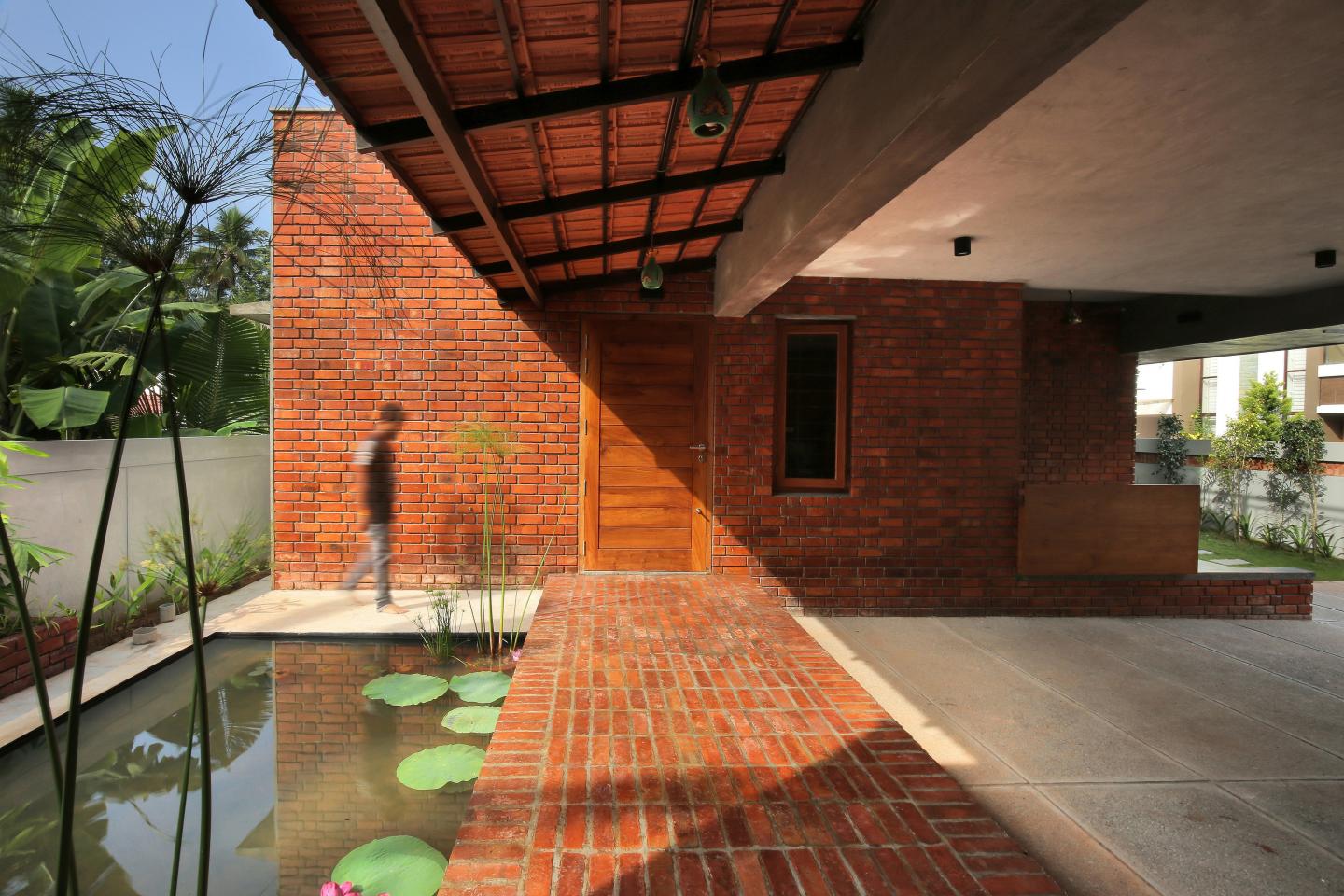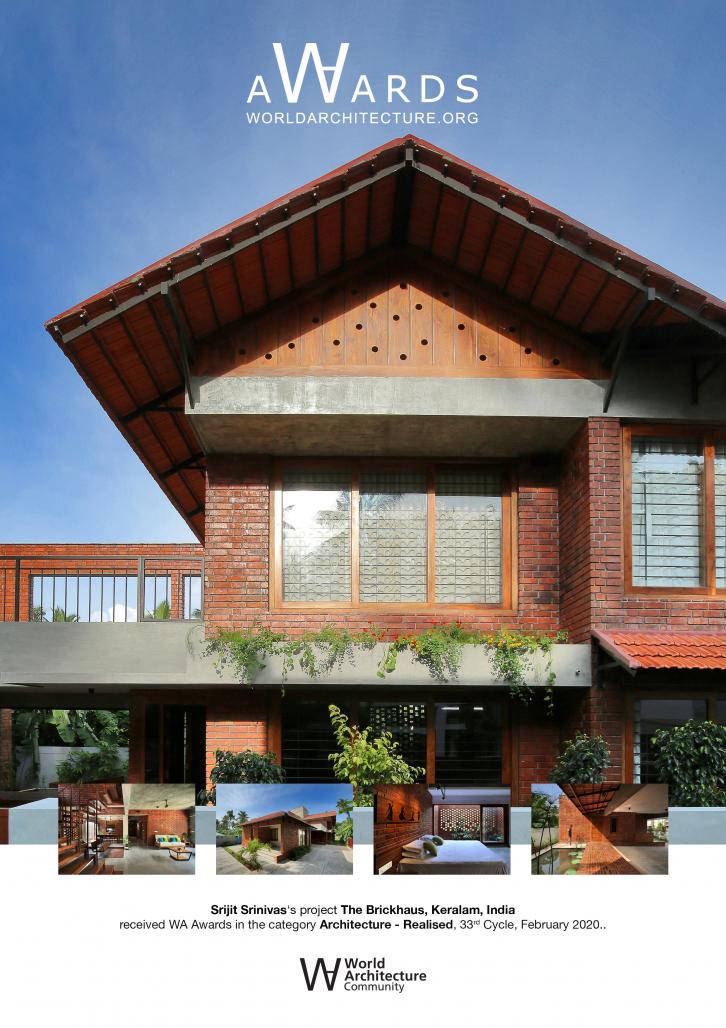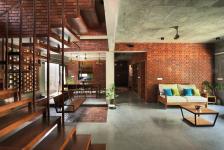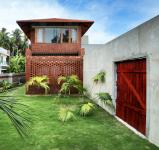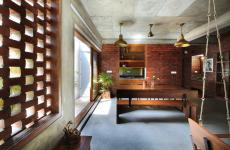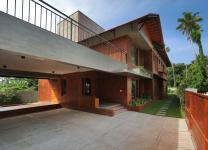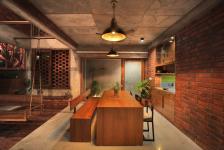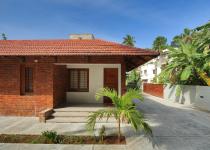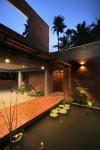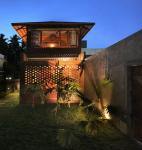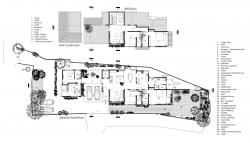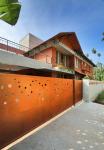The BRICKHAUS, Keralam, India : Located on a long and irregularly narrow site in Trivandrum with its longer side facing west, The BRICKHAUS, Keralam is designed to be both a place of respite and exhilaration for the Clients – a young family both Doctors, and their two kids. The lady of the house is also a trained dancer, and hence desired their home to have a stage-like quality, to provide a platform naturally lending itself to an organic expression of the vividness of life, as expressed in varied emergent moments of daily, familial living. The plan addresses the diverse requirements - a blend of novelty and function, and individual desires in dynamic tension with the need of the collective; a harmonising of the differential tugs of the inherent need for Public presentation contrasted against the sacred intimacy of Private expression. The BRICKHAUS honestly channels it’s genius loci, and confidently signals its cultural pedigree- rooted as it were in the very sacred earth from which it was built, brick by brick.
The BRICKHAUS is a story of open and interconnected spaces that challenge the standard assumptions of load bearing brick construction. With the natural variations of Brick, Polished and exposed Concrete, the house is also a celebration of the imperfection of the material and the asymmetry used everywhere. As a result, The BRICKHAUS naturally evokes a feel of nostalgia- of quietly taking the occupants back to days past, and to idyllic memories. The house has an ethnic charm, which is accentuated in varied play of shadows from the sun’s arc across the day interfacing with the placement and detailing of Jalis & fenestrations in the building envelope, and the material palette which has been used. The design has also attempted to bring nature indoors, with both the use of contextually detailed skylights and jaliwork – which defines breezeways facilitating natural cooling of the interiors, and complemented with a distribution of internal gardens and pools, all working together to bring in light as well as open up the building envelope to serendipitous glimpses of the world outside.
There is a dynamic play of light and volumes when one enters the house - the Jali works, the louvered gable and the skylight helps achieve this. The skylight, create an ever-changing pattern of light throughout the day which gives the inmates, an unique experience there at different times of the day. The house is an exploration in transitionally revealing the beauty of ‘burnt earth’ in the form of one of the oldest and most versatile man-made construction materials – the ubiquitous BRICK. The design and ensuing construction process was a purposeful journey of allowing exposed brick utilising a uniquely customised bond layout pattern, together with exposed concrete ceilings, polished concrete floors to lend rich texture, form and warmth to the tectonic ensemble.
The house becomes a celebration of the imperfection of the material substrate, and the organic expression of asymmetry conspicuously present throughout all adding to a sense of sensory dynamism. The custom-built furniture, and joinery items add to the charm of the house. Internally, the ethereally designed timber staircase and its juxtaposition to a traditional swing in the adjoining internal courtyard, uses the visual language of litheness and motion to tie together the larger layout of contingent spaces, whilst also allows through-views to allow for a sense of a spatial continuum of sorts.
From a functional layout, the Dining area with its east-west orientation opens out to a landscaped internal Courtyard, connecting the house with the ‘outdoors’. This functional syntax is carried across to other parts of the house also, such as the master bedroom having a landscaped court bounded by brick louvers bringing in cool breezes whilst also being privacy screen controlling views in from the outside.
The interior detailing is unique - the custom made artwork on wall in wood is specially for the lady of the house- doctor owner who is a trained dancer too.
Public vs Private: On this same theme, the Medical Consultancy space and its adjoined Guest Bedroom form a separate block spatially separate to the rest of the house, but nonetheless subtly blended in with the house such that the whole presents itself as a single entity. A carefully detailed brick-paved path forms the tectonic cord connecting the two spatial blocks together whilst also doubling up as a performance stage floor for small family gatherings. The quiet reflective brick-edged lotus pool besides informal stage gives a palpable and inviting vibe to this space.
In summary The BRICKHAUS, Keralam has tastefully responded to the unstated potential of its site, and to the aspirational requirements of its clients to deliver a restrained architectural end product, which is both visually capturing as well as functionally efficient, and an organic addition to the local semi urban milieu. Environmental Credentials : From an energy consumption perspective, Villa Brick is a ‘Net Zero’ entity, deploying a ‘Grid Tied’ power system with 5KWP of installed on-site solar capacity rated to produce 20 units of electrical output per day. The surplus generated power during the day is fed into mains supply grid, which then allows power from the grid to be drawn back at night, effectively allowing the owner to have access to electricity at nil cost. There is also a treated rainwater recharge system in place, whereby rainwater is filtered and let into the well to lift the water table. The treatment involves using pressure sand filter, iron removal filter, Activated Carbon Filter arrangement. Finally, organic waste is converted to Biogas and used in cooking.
2017
2019
Completion Date : 5th May 2019
Ground Floor Area : 2450 sq.ft.
First Floor Area : 1800 sq.ft.
Total Area : 4250 sq.ft.
Project location : https://maps.app.goo.gl/AwY2dvPp3DCNFHfM6
1. Wood Veneer - Decowood
2. Plumbing Fixtures - Grohe
3. lighting - Tulip, Changi, Hybec
4. Plywood - Trojan
5. Teak wood
Ar. Srijit Srinivas
The Brickhaus, Keralam, India by Srijit Srinivas in India won the WA Award Cycle 33. Please find below the WA Award poster for this project.

Downloaded 426 times.
Favorited 9 times
